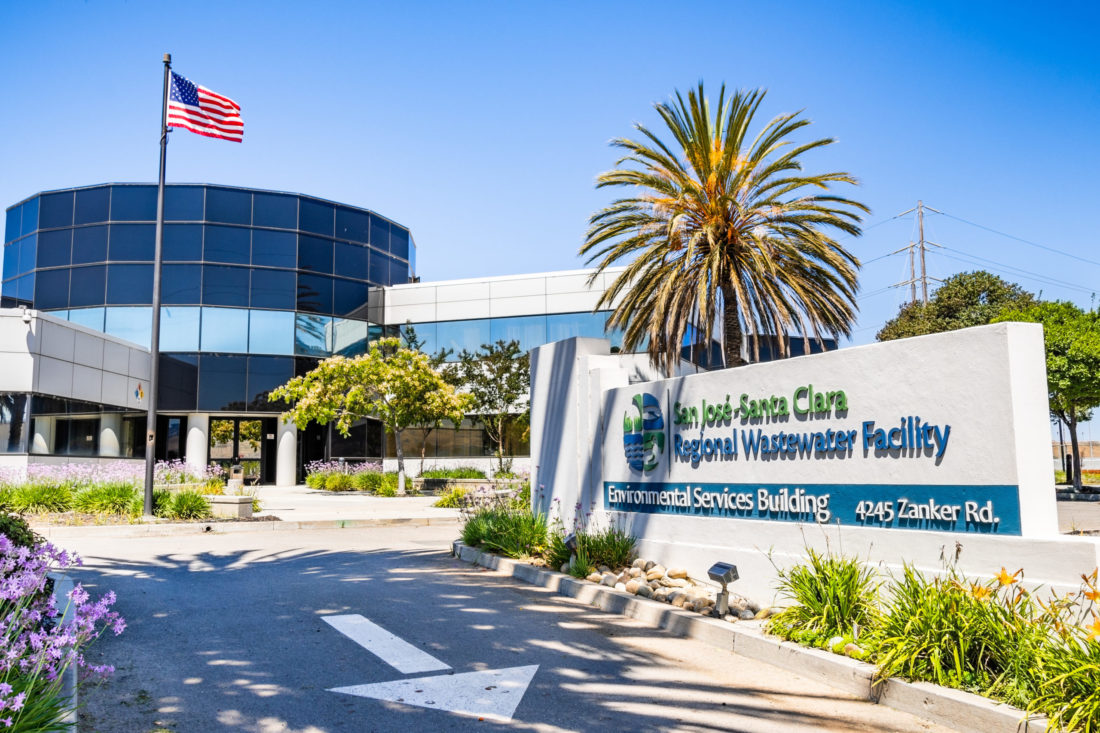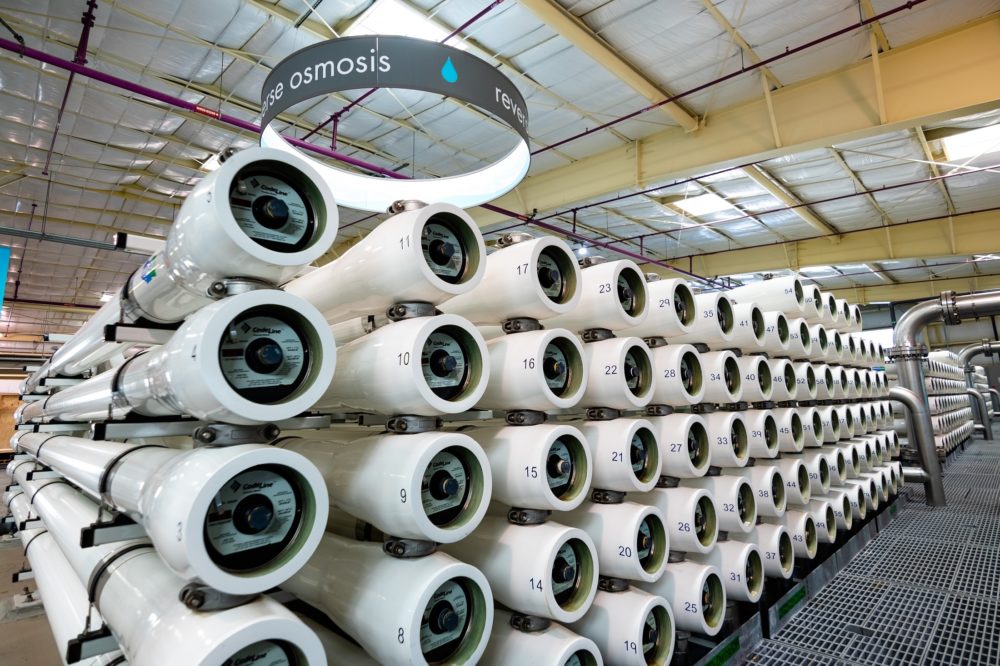
San José-Santa Clara Regional Wastewater Facility featured in the article
(credit: Sundry Photography, Adobe Stock).
![]() The mission of the US Environmental Protection Agency is to protect human health and the environment. An excellent example of an EPA program that achieves this goal is the Clean Water Act’s National Pretreatment Program.
The mission of the US Environmental Protection Agency is to protect human health and the environment. An excellent example of an EPA program that achieves this goal is the Clean Water Act’s National Pretreatment Program.
Established in the 1980s, Federal Pretreatment Requirements were established to prevent harmful industrial pollutants from being discharged into municipal wastewater treatment systems.
Pretreatment has grown, evolved, and improved over the years. It has the potential to be successful when it is implemented at the local level with support from the state and federal environmental agencies. Success is also dependent on effective enforcement strategies at each level.
When you hear people discuss the importance of enforcement, the most common statement is that proper enforcement creates a level playing field for the regulated community. That is, a municipality or company complying with environmental regulations should not be at a competitive disadvantage with a neighboring city or competitor.
Let’s focus on another aspect of enforcement that is also important: creating good working relationships between regulators and the regulated community.
There is no better place to view this relationship between regulators and the regulated community than looking from the point of view or local municipalities and sanitation districts that run pretreatment programs.
One interesting aspect of the National Pretreatment Program is that sanitation districts operating their local pretreatment program are both regulators and regulated organizations. in other words, they are stuck in the middle: they regulate industrial dischargers and they are regulated by the State or EPA to have a pretreatment program that, at a minimum meets State and Federal pretreatment requirements.

San Francisco Bay (photo by DWR)
A municipality or sanitation district with a total design capacity greater than five million gallons per day of wastewater is usually required to develop a pretreatment program. Each component of the local pretreatment program must be reviewed and approved by the State or EPA Approval Authority in concert with the local government approval process.
Once a pretreatment program is approved, it must be implemented. The municipality or sanitation district running the program is called the Control Authority because they control the implementation of the program.
A program must develop procedures to identify industrial users in their service area, notify significant industrial users of pretreatment requirements, sample wastewater from significant industrial users, investigate non-compliance, and communicate significant non-compliance to the public.
The Control Authority’s program is regularly audited by the Approval Authority, which could be the State or EPA. To illustrate the importance of enforcement, specifically the importance of a good working relationship between regulators and the regulated community, I would like to share some history of an approved program in EPA Region 9.
The City of San José has an approved pretreatment program that, after confronting deficiencies more than a decade ago, has matured into an outstanding program. The program has improved compliance among industrial users and developed an effective relationship with its Approval Authority, the San Francisco Bay Regional Water Quality Control Board, which receives support from the EPA as needed.
Back in 2001, the City of San José conducted an audit of its Pretreatment Program and decided to decrease the funding for pretreatment personnel and sampling, resulting in the reassignment of staff and reductions in compliance inspections and sampling.
This move by the city caught the attention of the Approval Authority and EPA, who kept an eye on the situation. Program deficiencies were identified during a program audit and significant industrial user inspections conducted in 2004. In January 2005, the San José/ Santa Clara Water Pollution Control Plant experienced a cyanide pass-through, resulting in treated effluent entering the San Francisco Bay with cyanide concentrations above the permit limits.
These violations and pass-through prompted EPA to issue an Administrative Order to the City that required program improvements to be completed within two years.
The 2005 EPA enforcement was just the beginning of building a professional relationship between the City, the Approval Authority and EPA. The City pretreatment staff were feeling squeezed by the lack of resources provided to them on one side and the requirements of the Order on the other side.
It took working through the order, changes in City upper management, and hiring new staff to backfill retired and reassigned staff to bring about a collaborative relationship. A turning point in the relationship between the Control Authority, Approval Authority, and EPA was the October 2009 program audit.
The audit findings spurred the City Pretreatment staff to view the audit process as an opportunity to improve the program. They reestablished an episodic night-time inspection program, improved surveillance work, refined their industrial user identification program, and bolstered outreach activities through an annual Industrial User Academy and quarterly newsletter.
Subsequent Pretreatment Program audits and inspections saw continued improvement in the program, which today is an exemplary Pretreatment Program. That’s only half of the story, since the City is also a regulator.

Reverse Osmosis modules at the Silicon Valley Advanced Water Purification Center operated by Valley Water. The facility turns wastewater fully treated by the San Jose-Santa Clara Wastewater Treatment Plant and turns it into purified drinking water. Pretreatment standards are a critical component in protecting the advanced water treatment facility. (credit: Sundry Photography, Adobe Stock).
The City’s relationships with its significant industrial users also changed. The cyanide pass-through in 2005 was a warning sign of compliance issues within its industrial users.
A multi-year investigation that included the collection of over 1,000 wastewater samples revealed that a significant industrial user, Variety Metals Finishing was bypassing its pretreatment system and sampling point and was discharging wastewater with elevated levels of cyanide and heavy metals and high and low pH.
This untreated industrial wastewater was a threat to the health of collection system and treatment plant professionals. It also had the potential to corrode the collection system that could lead to contamination of the environment. A formal enforcement action was necessary.
In 2005, Variety Metals was referred to the City of San José Attorney’s Office and Santa Clara County District Attorney for violations of local and federal discharge limits, and in 2007, a settlement was placed before the court.
On February 6, 2009, the Superior Court of California issued a Permanent Injunction and Stipulated Final Judgement that required the facility to pay $600,000 in cost recover and $800,000 in civil penalties.
The judgement also required the facility to install a locked monitoring point in the sewer lateral and faced stipulated penalties for any violations.
In 2008, the City conducted a 15-week surveillance monitoring investigation of Express Tech, a categorical industrial user that claimed to be a zero discharger. The sampling results from the surveillance work, which was conducted outside of business hours, detected elevated levels of copper and nickel that exceeded local limits.
In 2008, the City and Santa Clara County District Attorney conducted a joint night-time search warrant investigation at Express Tech, ultimately discovering video evidence of illicitly discharges of untreated wastewater.
The flagrant disregard of pretreatment requirements and dishonest claim to be a zero discharger undermines the integrity of a pretreatment program. A formal enforcement action was necessary. The enforcement case against Express Tech resulted in the owner serving a year in jail, three years formal probation and paying fines of $36,500.
Several other Express Tech employees were ordered to pay fines, placed on probation, and sentenced to a combination of jail terms and community service with environmental agencies. The company paid $113,885 in civil penalties and the costs of the investigation.
These two important enforcement cases as well as other, less dramatic, enforcement actions that the City of San José completed during this timeframe resulted in improved compliance by its industrial users. It also resulted in better communication between the City and industrial users.
Conducting inspections and initiating enforcement actions is an ongoing process to ensure compliance with pretreatment requirements, and one that requires effort from local, state, and federal officials. The EPA and State inspect and audit pretreatment programs and take enforcement actions against municipalities and industrial users when necessary. Two recent examples are the City of Lompoc and Parker Hannifin.
The City of San José continues to make program improvements and is currently focusing on re-working toxic organic management plans with its industries to make them more effective and more efficient.
The City is also focusing on research and development facilities to verify that they are categorized correctly and tracking emerging pollutants that are identified regionally within the San Francisco Bay.
The City was able to convince one of its industrial users, Clean Harbors in San José, to host more than 30 EPA inspectors in a classroom in-brief and then facility walk-through.
A special thanks goes to Casey Fitzgerald, Pretreatment Program Manager, and his staff at the City of San José Pretreatment Program for providing information for this article and for doing such a great job in running and improving their program.
Working relationships between regulators and the regulated community are strengthened by ongoing communication. Sometimes that communication starts with an enforcement action.
The important thing is to continue communicating. Ongoing communication between regulators and the regulated community creates better pretreatment programs, which protects human health and the environment.

US EPA Region 9 team members Amelia Whitson (l) and Jim Polek (r) share a fun, virtual and socially distanced author photos.
Jim Polek is an Environmental Engineer in US EPA Region 9‘s Enforcement and Compliance Assurance Division.